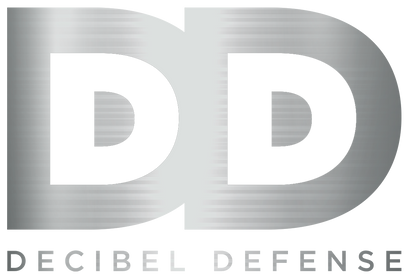Your Cart is Empty

Industrial Hearing Protection
March 12, 2025 3 min read
In industrial settings, particularly factories, workers are frequently exposed to high levels of noise that can lead to permanent hearing loss and other health issues. Implementing effective hearing protection strategies is crucial to safeguard employees' well-being and ensure compliance with occupational safety regulations. Among various protective devices, safety earmuffs, such as those offered by Decibel Defense, stand out as a reliable solution for mitigating noise-induced hazards in factory environments.

Understanding Noise-Induced Hearing Loss in Factories
Noise-induced hearing loss (NIHL) is a prevalent occupational hazard in manufacturing and industrial sectors. Continuous exposure to elevated noise levels can damage the sensitive structures within the inner ear, leading to irreversible hearing impairment. According to the Occupational Safety and Health Administration (OSHA), approximately 22 million workers in the United States are exposed to potentially damaging noise each year.
OSHA's Noise Exposure Standards
To combat the risks associated with occupational noise exposure, OSHA has established permissible exposure limits (PELs). The standard PEL for noise is 90 decibels (dB) over an 8-hour time-weighted average (TWA). Additionally, OSHA mandates that employers implement a hearing conservation program when noise exposure reaches or exceeds 85 dB over an 8-hour TWA.
Health Implications Beyond Hearing Loss
Beyond hearing impairment, chronic exposure to high-decibel environments has been linked to other health concerns. Research indicates that working in noisy environments, such as factories, significantly increases the risk of high blood pressure. Chronic exposure to industrial noise raises these risks by 10% for each year of employment. The stress response to chronic noise causes hormonal imbalances leading to high blood pressure. A study involving 289 power loom workers in Narayanganj found a 31.5% rate of hypertension and a 53.3% rate of pre-hypertension among participants who didn't use ear protection.
The Role of Hearing Protection Devices
Employers are responsible for providing adequate hearing protection to workers exposed to hazardous noise levels. Hearing protection devices (HPDs) are essential components of a comprehensive hearing conservation program. The two primary types of HPDs are earplugs and earmuffs.
Advantages of High Performing Safety Earmuffs
While both earplugs and earmuffs serve to attenuate noise, safety earmuffs offer distinct advantages, particularly in factory settings:
-
Ease of Use: Earmuffs are generally easier to fit correctly compared to earplugs, reducing the risk of improper usage that can compromise protection.
-
Consistency in Protection: Earmuffs provide a consistent level of noise reduction, as they are less dependent on individual fit and insertion technique.
-
Visibility: Earmuffs are more visible, allowing supervisors to monitor compliance with hearing protection policies easily.
-
Compatibility with Other PPE: Earmuffs can be worn in conjunction with other personal protective equipment, such as helmets and face shields, without compromising their effectiveness.
Decibel Defense Safety Earmuffs: A Superior Choice
Decibel Defense offers safety earmuffs that exemplify quality and effectiveness in hearing protection. Key features include:
-
High Noise Reduction Rating (NRR): Decibel Defense earmuffs boast an industry-leading NRR, providing substantial protection against hazardous noise levels.
-
Comfortable Design: The earmuffs are designed with comfort in mind, featuring cushioned ear cups and an adjustable headband to ensure a secure and comfortable fit for extended wear.
-
Durability: Constructed with high-quality materials, these earmuffs are built to withstand the rigors of industrial environments, ensuring long-term reliability.
-
Affordability: Despite their premium features, Decibel Defense earmuffs are priced competitively, making them accessible for widespread use in factory settings.
Implementing Hearing Conservation Programs
To effectively protect workers from noise-induced hazards, employers should implement comprehensive hearing conservation programs that include:
-
Noise Monitoring: Regular assessment of noise levels in the workplace to identify areas where exposure exceeds permissible limits.
-
Engineering Controls: Implementing measures to reduce noise at the source, such as maintaining equipment and installing noise-dampening materials.
-
Administrative Controls: Scheduling work to minimize exposure duration and rotating employees to limit individual noise exposure.
-
Provision of HPDs: Supplying appropriate hearing protection devices, like Decibel Defense earmuffs, and ensuring their proper use.
-
Training and Education: Educating workers about the risks of noise exposure and the correct use and maintenance of hearing protection devices.
-
Audiometric Testing: Conducting regular hearing tests to monitor employees' hearing and identify any early signs of hearing loss.
Conclusion
Hearing safety in factories is a critical aspect of occupational health and safety. Implementing effective hearing conservation programs and providing high-quality hearing protection devices, such as Decibel Defense safety earmuffs, are essential steps in safeguarding workers from noise-induced hearing loss and associated health risks. By prioritizing hearing protection, employers not only comply with regulatory standards but also promote a healthier and more productive workforce.
Subscribe
Sign up to get the latest on sales, new releases and more …
